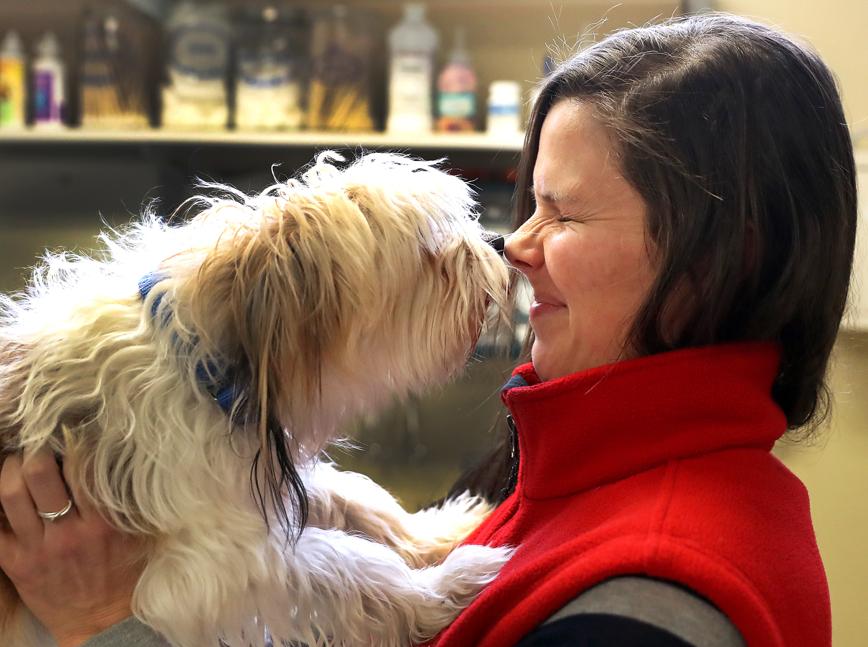
Itried to focus on dog books for this column — I hoped this week’s Westminster Dog Show would help — but found it hard to think about anything except Donald Trump. Then a friend rescued me. How? By deftly meshing both topics: He said the combative Mr. Trump, who never expected to win the presidency, but then did, is like “the dog that caught the car.’’
And this inspired me to consider both canine and human behavior and how dogs — even though their DNA is 99.96 percent wolf — embody “the survival of the friendliest.’’ Or so say Brian Hare and Vanessa Woods. They’re the husband-wife authors of “The Genius of Dogs: How Dogs Are Smarter Than You Think’’ (Dutton, 2013).
Hare, an evolutionary anthropologist, founded the Duke Canine Cognition Center, and Woods is a research scientist and writer. They get the irony of this genius business: “Can I really be serious about the title?’’ the book begins. Dogs “are baffled when a squirrel disappears up a tree by circling the trunk, and most will happily drink out of the toilet bowl. This is not the profile of a typical genius.’’
Indeed. Most dogs aren’t Rico or Chaser; since 2004 researchers have taught these border collies to fetch some thousand different objects by name. It turns out dogs learn a bit like human infants; they infer that a new word belongs to a new object. And Hare and Woods take us for a walk through the breakthrough research of the last decade (including their own) about how dogs think.
This dogged ability to learn, plus their fantastic affinity for humans, plus their acute sense of smell make dogs “arguably the most successful mammal on the planet.’’ Think about it: Human presence has spurred the decline of nearly all other mammal populations. But we live in a booming era of canine ownership, relying on service dogs and using them to sniff out everything from bombs to bedbugs to cancer tumors. There’s the genius: Dogs are better at living with people than any other animal.
John Bradshaw founded and directs the Anthrozoology Institute at the University of Bristol. And he retrieves even more insight in “Dog Sense: How the New Science of Dog Behavior Can Make You A Better Friend to Your Pet’’ (Basic, 2014). I really liked Bradshaw’s coverage of dog evolution, for instance: In 1997, DNA sequencing determined that modern dogs are descended from the gray wolf, which evolved from the borophagine, a huge prehistoric quasi-hyena. Our earliest evidence of man’s best friend comes from a set of 26,000-year-old footprints alongside pawprints — a boy and his dog — found in a cave in France.
Bradshaw dislikes our overheated era of breeding for pedigree; in many breeds, the genetic variation is as low as first cousins in humans, a looming disaster. Bradshaw also warns us off anthropomorphism; studies show dogs can feel love, yes, but not guilt. No matter that they just ate the Easter ham.
“The Other End of the Leash: Why We Do What We Do Around Dogs’’ (Ballantine, 2002) has a cinematic opener. A 200-pound mastiff lunges at the author onstage at a training seminar; she made the mistake of making eye contact with him. Patricia B. McConnell is an animal behaviorist who teaches at the University of Wisconsin-Madison. “Dogs are brilliant at perceiving minute changes in our bodies and assume each tiny motion has meaning,’’ she writes. In fact, when we imperceptibly shift our weight it’s “a neon sign’’ to dogs. Cool tidbits: Dogs are more likely to obey our sit command when we stand with our shoulders squared not slumped. And how we breathe can spur or stop a dogfight.
Alexandra Horowitz, who teaches canine cognition and animal behavior at Barnard, knocked me out with her chapter on how dogs smell in her “Inside of a Dog: What Dogs See, Smell, and Know’’ (Scribner, 2009). We inhale when we sniff, but dogs inhale and exhale simultaneously. This creates a wind current that brings in more scents, which are also trapped by their wet noses. We have 6 million scent receptors in our nostrils. Dogs can have as many as 300 million. They can detect a spoonful of sugar in a million gallons of water.
What else? Dogs may lick your face because, as puppies, when they licked their mother’s face she’d regurgitate food (not something you should try at home). Also, many small dogs hate being put in raincoats and sweaters because the fabric’s weight reminds them of getting stepped on by bigger dogs.
For the first presidency in 150 years, the White House is without a pet. If our 45th president’s next four years are anything like his first weeks, he might heed the wisdom of our 33d. As Harry Truman waggishly advised: “Want a friend in Washington? Get a dog.’’
Katharine Whittemore can be reached at katharine.whittemore@comcast.net.



